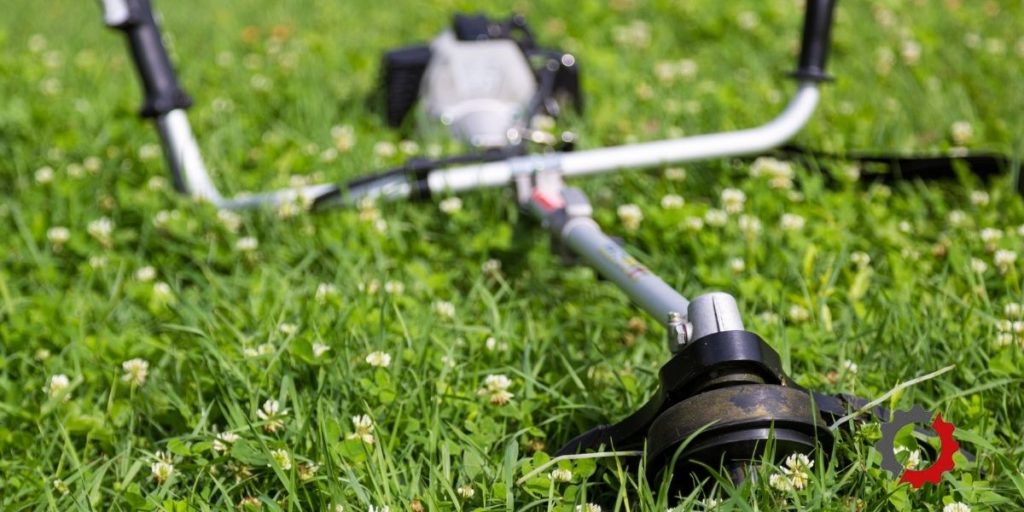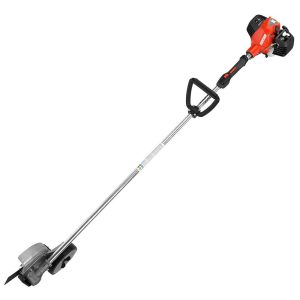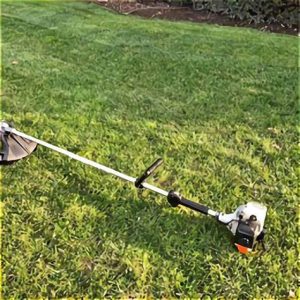Your String Trimmer Starts Then Dies: FIX IT NOW!
Using your string trimmer to add the finishing touches to your lawn care by trimming around the landscaping, the fence posts and your pond makes your home’s exterior look complete.
It is also a great tool for those “hard to mow” places and tall grasses. When your string trimmer dies, your need to get it fixed.
A string trimmer will start and then die when it isn’t getting fuel to the engine due to running old or dirty fuel that clogs the fuel filter, fuel line, fuel vent, or carburetor. It will also quit when the air filter is plugged, the spark arrestor is clogged or the choke setting is incorrect.
Before repairing your string trimmer, disconnect the spark plug and wait for all moving parts to stop.

This post may include affiliate links. Purchases made through these links may provide a commission for us, at no extra cost to you. As an Amazon Associate, we earn from qualifying purchases.
Follow all safety instructions provided in your equipment operator’s manual prior to diagnosing, repairing, or operating.Consult a professional if you don’t have the skills, or knowledge or are not in the condition to perform the repair safely.
Table of Contents
7 Reasons Your String Trimmer Starts Then Dies
Incorrect Choke Setting Causes a String Trimmer to Start Then Die
A string trimmer has a choke to restrict airflow to the engine so a higher concentration of fuel is allowed to start a cold engine. When the engine warms up, the choke must be turned off to allow a normal rate of air to be combined with fuel to keep running.
When the choke isn’t properly adjusted after the engine warms, the engine will die when it can’t get proper airflow.
Plugged Air Filter Causes a String Trimmer to Start Then Die
Just like the engine will die from a lack of air when the choke is left on, it can quit from a lack of air when the air filter becomes plugged. Dirt and debris get tossed into the air when using a string trimmer. These dirty conditions can plug the air filter and cause the trimmer to die.
It’s good practice to replace the air filter annually when completing a full annual service. Periodically check the air filter to clean it and make sure it is in good condition.
Replace it if it becomes very dirty or damaged. Never run your string trimmer without an air filter, even if it’s only for a short time while waiting for a new filter.
If you find your air filter is plugged, I recommend replacing the filter. The small air filter is usually not very expensive. It is an important component when it comes to protecting the engine.
A foam, fabric, or felt-style filter can be cleaned using a mild dish detergent and water. Wash the filter to remove as much dirt as possible. Rinse until clear.
A paper filter can be cleaned by knocking it against a solid surface to remove as much dirt as possible. Hold it up to a light source to see if you can see light through the element.
Reuse the filter if you can still see light. Replace the filter if you cannot see light, your filter is very dirty or it is covered in oil.
Because there are so many different types of filters used which varies by manufacturer and model of the trimmer, refer to your operator’s manual for steps to clean the style of air filter in your string trimmer.
Old or Bad Fuel Causes a String Trimmer to Start Then Die
Gasoline that has been sitting around for over 30 days can begin to break down and lose some of its combustible properties.
Old fuel attracts moisture that can leave behind varnish and sticky deposits that clog the fuel system and cause string trimmer components to fail. Ethanol-based gasoline can have negative effects on your string trimmer.
Use unleaded gasoline with a minimum octane rating of 89 and a maximum ethanol content of 10%. A low ethanol content or ethanol-free fuel is best for your fuel system and engine.
Add a fuel stabilizer like Sea Foam Motor Treatment when you are unable to use fuel within 30 days of purchase.
Most string trimmers today use a 2-cycle (2-stage) engine that requires gasoline and oil to be mixed before filling the fuel tank.
You will also find manufacturers beginning to release 4-cycle (4-stage) string trimmers to the market. Oil and gas are not mixed for these types of engines.
Know what type of engine is on your string trimmer so you don’t ruin your string trimmer. Adding the wrong type of fuel to your string trimmer can damage the unit beyond repair.
Read more about identifying the type of engine on your string trimmer and the fuel to use in, “This is the Type of Gas to Use in a String Trimmer“.
Plugged Fuel Filter Causes a String Trimmer to Start Then Die
A fuel filter that strains fuel to keep dirt and debris from entering the fuel system can become plugged when it isn’t changed out regularly. A plugged filter will restrict the amount of fuel that is allowed to flow to the engine causing it to start and then quit.
You will find the fuel filter in the fuel tank. To get to the filter, wipe any dirt from the fuel cap and remove the cap. You will need to pull the filter out of the tank. Use a clean wire to “fish” the fuel filter out of the tank.
Holding onto the fuel line and ring clamp with one hand, pull the fuel filter out of the fuel line. Don’t let the ring clamp fall off the fuel line. Insert the male end of the new fuel filter into the fuel line and then slide the ring clip over the fuel line and filter to secure the line to the filter.
Clogged Fuel Lines Cause a String Trimmer to Start Then Die
The fuel lines can become clogged with dirt and sticky deposits left behind by old or bad fuel. Look for a clog or kink in the fuel line. You may be able to see clogs through some fuel lines, while others are too dark to see through.
To determine if you have a fuel restriction, remove the fuel line off the carburetor to see if you are getting good flow. Replace any fuel line that is dry, cracked, clogged, or kinked with a new fuel line.
Plugged Fuel Tank Vent Causes a String Trimmer to Start Then Die
The fuel tank has a vent to allow air to pass through it. When the vent no longer functions correctly and becomes plugged, the fuel tank will act like a vacuum. Fuel will no longer flow out of the tank and through the fuel lines.
If you are not getting fuel to the carburetor and you are running a good filter and you don’t have any clogs in the fuel lines, you may have a clogged fuel vent.
You can test the vent by placing your string trimmer on a level surface. Remove the fuel cap to allow air into the tank and start the trimmer. Don’t allow gas to spill out of the fuel tank.
When the trimmer starts and runs, replace the fuel cap with the trimmer still running. Continue to let it run for a while.
If it sputters and dies with the cap on and then immediately starts and runs once the cap is removed, you most likely have a problem with the fuel tank vent. Replace the vent with a new fuel tank vent.
Dirty Carburetor Causes a String Trimmer to Start Then Die
The carburetor mixes the correct proportion of air and fuel required for your string trimmer to run. The passageways can become clogged and the small components can fail to function correctly.
This can cause an insufficient amount of fuel mixed with air resulting in a rough running string trimmer that may just quit.
You may be able to clean your carburetor to get it working again. You may end up having to rebuild (if rebuild kits are available for your carburetor) or replace the carburetor if cleaning doesn’t help.
Plugged Spark Arrestor Causes a String Trimmer to Start Then Die
There is a small metal screen that keeps hot exhaust material from shooting out of the string trimmer and causing injury or starting a fire. This small screen will become plugged with a carbon buildup that will affect how the engine runs.
Solution: Disconnect the spark plug wire. Remove the engine cover and the engine exhaust cover. Carefully remove the spark arrestor screen. Clean it with a wire brush. Reinstall the screen.
If the screen isn’t able to be sufficiently cleaned or you find it is damaged or has a hole in it, replace it with a new spark arrestor screen.







